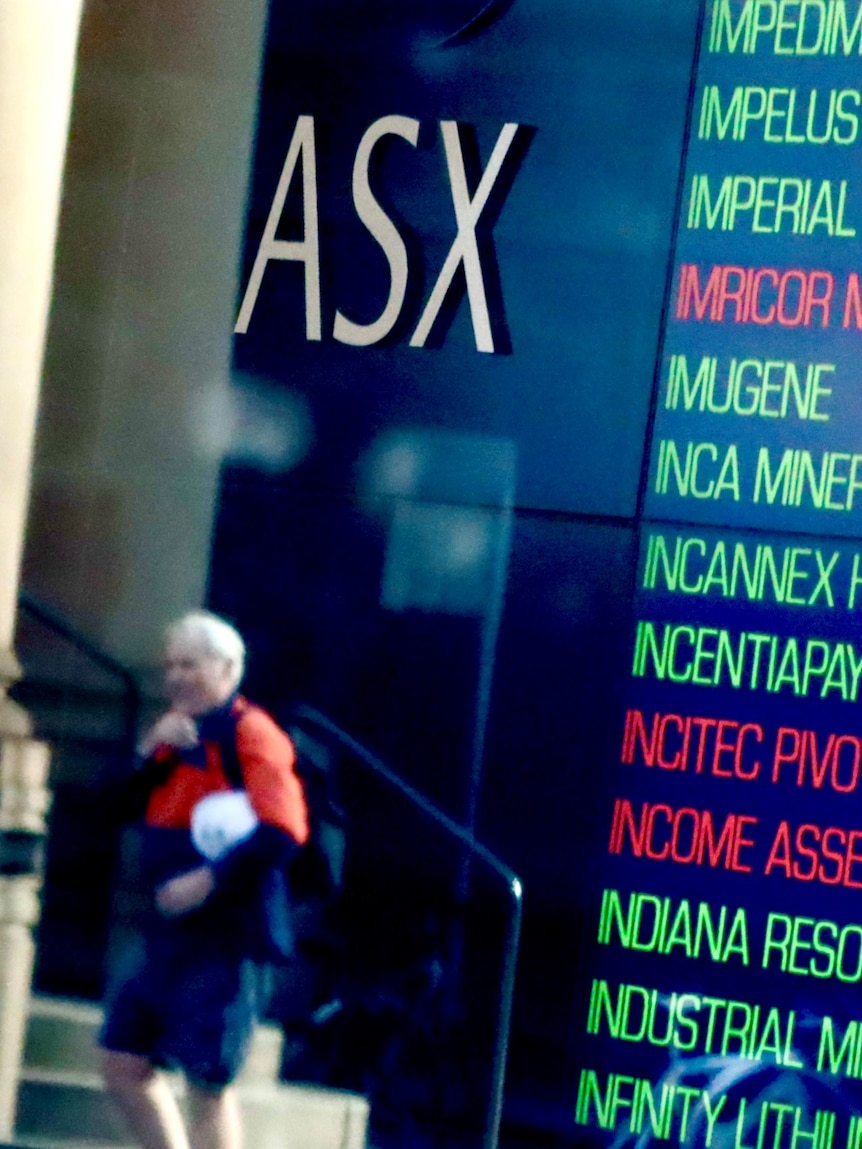In some ways, it turned out to be a better-than-expected year for Australian workers, trying to grow their retirement savings during a cost-of-living crisis.
For those who invested their superannuation in a Balanced option, the average return was about 9 per cent in the last financial year, rising to 11 per cent for those who were happy to take more risk with a Growth option.
“Super has done much better than expected over the last financial year,” said SuperRatings insights manager Joshua Lowen.
“In the first half of the year, share markets didn’t perform particularly well, but from about November 2023, international and Australian share markets really picked up,” he said.
Shares are a major driver for most people’s superannuation balances.
“And so that recovered those early losses and then actually exceeded expectations to bring returns for the year above the long-term average, which sits around 7 per cent.”
What drove share markets higher? Banks!
The ASX 200, is sitting near record high levels, after rising nearly 8 per cent in the 2023-24 financial year. (When dividends are included, Australia’s benchmark stock index has gained more than 12 per cent.)
The gains were driven mainly by the financial sector, with NAB shares jumping 38 per cent in the past year, to their highest value since December 2007 (just before the global financial crisis).
Commonwealth Bank’s share price jumped 27 per cent during that period, and briefly hit a new record high ($128.68) in late June.
“What we’ve seen with the banking sector, in particular, is they raised a lot of money during COVID, expecting bad debt losses to come through over the last few years, which haven’t materialised,” said Wavestone Capital portfolio manager Catherine Allfrey.
“What they’ve done instead is return that capital to shareholders, so they’ve been buying back their stock.
“In the case of Westpac, they also paid a special dividend, so that’s actually been very positive for the share price performance.
“Also, the backdrop economically has been better for the banks. So if the economy is performing reasonably well, and there’s no bad debts on the horizon, then clearly, those sectors have been re-rated [higher].”
Consumer discretionary stocks did surprisingly well
NabTrade’s head of investor behaviour Gemma Dale was surprised about the kinds of stocks which performed well.
“The performance of different sectors has been really counterintuitive,” she said.
“What you were expecting to perform really well – in what’s a sluggish economic environment – has not performed so well. And what you’re expecting to perform really poorly actually probably shot the lights out.”
In particular, she was referring to the consumer discretionary sector, which jumped 23 per cent over the past year.
Some of the best performers in that sector include jewellery chain Lovisa (74 per cent) and Premier Investments (56 per cent), the owner of Peter Alexander, Smiggle, Just Jeans and other retail brands as well as JB Hi-Fi (43 per cent).
“The consumer is holding up relatively well, but we’re certainly in a per capita recession, people are spending less.
“There’s a massive gap between the ‘haves’ and ‘have nots’ when it comes to spending.
“So younger people, particularly those who don’t own homes are in real trouble, as rents have gone up dramatically.”
Consumers gradually tightened their discretionary spending budgets, but they only started adding new notches in the last few months, according to Ms Allfrey.
“And so for the first sort of nine months of this financial year, what we actually saw was consumer savings being run down but wage growth was better than expected.
“So that was holding the economy up on top of the very-strong immigration that we’ve seen. And that’s really held up those consumer stocks.”
Supermarkets tanked
In contrast, the consumer staples (-6 per cent) was the worst-performing ASX sector.
It was dragged down by shares of Coles (-8 per cent) and Woolworths (-15 per cent), in particular, over the past year.
“That’s the kind of company that you think is going to continue performing,” Ms Dale said.
“When you know that consumers are under pressure, for example, they’re still going to buy groceries. Not the case!”
That was predominantly driven by cost-of-living pressures, pricing pressures and the political pressure being put on those companies, according to Ms Allfrey.
“But we also had a change in CEO at Woolworths too. So that was a big change there.”
AI craze lifts tech sector
Technology was the best-performing ASX sector, up more than 30 per cent over the past year.
The tech stocks that made the biggest gains include Life360 (+120 per cent), Altium (+87 per cent), Megaport (+66 per cent) and Zip Co (+252 per cent).
Analysts said that’s partly because the upbeat sentiment in the US tech sector is rubbing off here.
On Wall Street, the Nasdaq Composite jumped 32 per cent in the past year.
It was driven in particular by the AI chipmaker Nvidia, which surged more than 200 per cent to (briefly) become the world’s most valuable company — with a market value of $4.67 billion.
“One of the big themes in the last 12 months has been AI,” Ms Allfrey said.
“And the stocks that are exposed to that, in Australia’s case, have been the data centres, whether it’s NextDC [+44 per cent] or Goodman Group [+71 per cent], have performed exceptionally well.”
Lithium fares poorly
One thing is clear when we look at the list of worst-performing stocks.
Many of them are lithium companies – and none of them are earning profits. They include Core Lithium (-89 per cent), Lake Resources (-86 per cent), Piedmont Lithium (-83 per cent), Global Lithium Resources (-82 per cent), Galan Lithium (-81 per cent), Sayona Mining (-78 per cent) and Liontown Resources (-68 per cent).
After surging astronomically in recent years, the hype for lithium has died down, Ms Dale observed.
“People were looking at the next big thing, it was all about lithium and battery technology.
“Seeing Tesla [shares] go to the Moon, there was just a lot of heat in that sector.
“And what it meant was that investors were chasing a lot of companies that were not hyper viable. There was a lot of hype.”
Indeed, Tesla’s share price has dropped 23 per cent in the past year, on slowing sales and intensifying competition in the electric vehicle market.
Not to mention, the price of lithium has slumped by more than 70 per cent during that period.
“Those [lithium companies] who have sort of strong viable business models will perform in the long run.
“The ones that were a little bit more speculative might not play out quite so well,” Ms Dale said.
An increase in the supply hitting the market, particularly cheaper African-sourced lithium, as well as a slump in overseas EV demand weighed on prices, according to Ms Allfrey.
“We’re just not seeing the same level of demand – and in the growth rate that the market was expecting — and hence, you’ve seen those [lithium] names sell off substantially.”
What are the biggest risks ahead?
Although many analysts expect the share market to grind higher, and hit new record highs, on hopes of the RBA cutting interest rates, they’re also warning there are some risks ahead.
One of them is China, our biggest iron ore customer, where fears of an economic downturn loom large.
The Chinese economy has been affected by weak consumer sentiment and a prolonged property downturn.
“I think for Australian investors, they’re going to be worried about things like the iron ore price, and what’s happening in the Chinese property market,” Ms Dale said.
“We’ve been worried about that for a very, very long time but the iron ore price has somewhat defied expectations, despite that.
“So I think a lot of investors are concerned there’ll be a big pullback there, and that really does affect the Australian stock market as BHP is such an enormous chunk of it.”
Ms Dale also identified cost-of-living pressures as another risk.
“Australian households are the second largest debt holders in the world, and that has massive implications for our financial sector, if we see an uplift in unemployment.
“You’d be pretty worried about things like consumer discretionary as well.
“But we were having this conversation 12 months ago and ironically, these are the sectors that have performed better, so it’s dangerous to make predictions.”
Ms Allfrey agrees that one of the biggest risks ahead is what happens to the Australian consumer, given consumer spending accounts for around 60 per cent of the nation’s economic growth.
Weaker spending could lead to higher unemployment (as struggling businesses cut costs by laying off workers). And the federal government’s cuts to immigration could lead to weaker economic growth.
“The final risks that I’ll call out is the US election. Who knows how that’s going to impact … if Trump is victorious? And the impact on tariffs and global trade, given we [Australia] are a global trading nation.
“So we need a stable geopolitical environment for our exports to be successful.”
Posted , updated




